
Cargado el 5 de noviembre, 2009
Galería de Hans Ollermann
King Ramses II (also called Ramses the Great) 1279-1212 B.C.
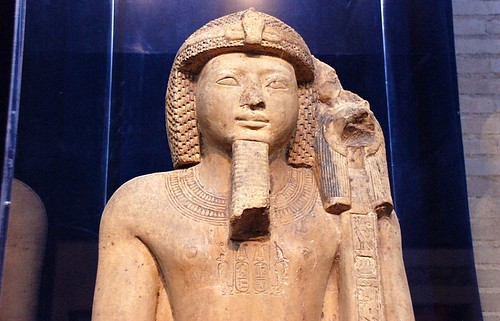
2007_0727_163904AA
Statue of Ramesses III.
Dynasty 20, reign of Ramesses III (1187-1156 B.C.).
Limestone.
Ramesses II was the last of a long line of powerful militairy pharao's, beginning with Thutmosis III.
University of Pennsylvania Museum, Philadelphia.
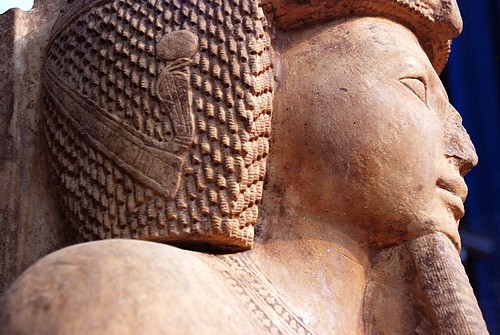
2007_0727_164007AA
Statue of Ramesses III.
Dynasty 20, reign of Ramesses III (1187-1156 B.C.).
Limestone.
Ramesses II was the last of a long line of powerful militairy pharao's, beginning with Thutmosis III.
University of Pennsylvania Museum, Philadelphia.
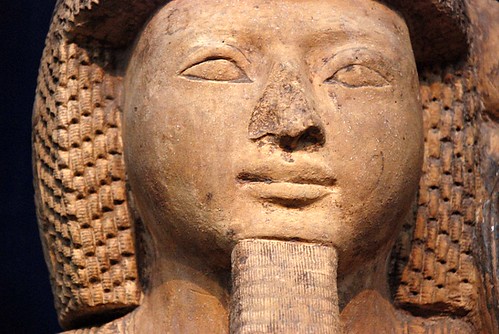
2007_0727_163907AA
Statue of Ramesses III.
Dynasty 20, reign of Ramesses III (1187-1156 B.C.).
Limestone.
Ramesses II was the last of a long line of powerful militairy pharao's, beginning with Thutmosis III.
University of Pennsylvania Museum, Philadelphia.
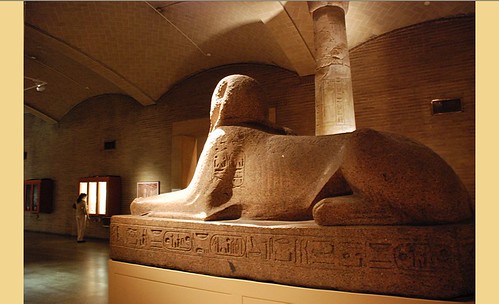
2007_0727_170116AA-2
The third largest known Sphinx in the world in a majestic and almost magical setting of the University of Pennsylvania Museum.
The Sphinx once stood in the Palace of King Merenptah at Memphis, Egypt.
Dynasty 19, Reigns of Ramesses II and Merenptah (1279-1204 B.C.)
The Sphinx, a lion with a human head, represents the power of the Egyptian king. both to protect his people and to conquer the enemies of Egypt.
This Sphinx was burried up to its shoulders; only the exposed head was attacked by windblown sand, which eroded the facial features and the royal false beard. The inscriptions on the chest and around the base give the five names of Ramesses II. His son and successor Merenptah added his own cartouches to the shoulders after his father's death. This most impressive sphinx weighs about twelve tons. It was quarried at Aswan and transported by river to the Ptah Temple at Memphis, 600 miles away.
University of Pennsylvania Museum, Philadelphia.
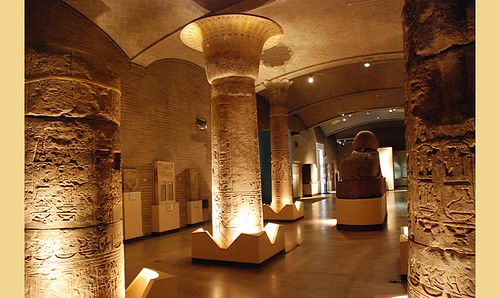
2007_0727_170000AA
The third largest known Sphinx in the world in a majestic and almost magical setting of the University of Pennsylvania Museum.
The Sphinx once stood in the Palace of King Merenptah at Memphis, Egypt.
Dynasty 19, Reigns of Ramesses II and
Merenptah (1279-1204 B.C.)
The Sphinx, a lion with a human head, represents the power of the Egyptian king. both to protect his people and to conquer the enemies of Egypt.
This Sphinx was burried up to its shoulders; only the exposed head was attacked by windblown sand, which eroded the facial features and the royal false beard. The inscriptions on the chest and around the base give the five names of Ramesses II. His son and successor Merenptah added his own cartouches to the shoulders after his father's death. This most impressive sphinx weighs about twelve tons. It was quarried at Aswan and transported by river to the Ptah Temple at Memphis, 600 miles away.
University of Pennsylvania Museum, Philadelphia.
Intef I
De Wikipedia, la enciclopedia libre
Sehertauy Intef, o Intef I considerado el auténtico fundador de la dinastía XI de Egipto, y gobernó desde Tebas de c. 2119 a 2103 a. C., probablemente en corregencia con su padre Mentuhotep I "el viejo", un líder local (Dodson, Malek).
Biografía [editar]
En esta época Egipto estaba dividido e intentó reunirlo bajo su control. Consiguió agrupar en torno a su persona a todos los nomarcas del sur, a través de la diplomacia o de la fuerza. Inmediatamente después se proclamó faraón y gobernó sobre todo el Alto Egipto, estableciendo su capital en Tebas, incluso llegó a escribir su nombre en un cartucho y así tener un nombre de Horus como los antiguos faraones.
Le fue posible oponerse a los más poderosos gobernantes de Heracleópolis porque había tan profunda enemistad entre los diferentes contendientes que solo el proclamarse enemigo levantaba seguidores. Pero los reyes de Heracleópolis, en el Bajo Egipto, retuvieron el poder durante su reinado, lo que originó un siglo de guerras civiles.
Intef I se enfrentará con el monarca heracleopolitano Neferkara, abriéndose una profunda brecha por la separación de Egipto en dos grandes bloques dirigidos por ambos soberanos. Las relaciones entre ambos territorios entrarán en un periodo de calma, rota por puntuales conflictos fronterizos que provocarán una verdadera guerra de la que tenemos constancia por las inscripciones encontradas en la tumba de Anjtifi, aliado de Neferkara. Anjitifi luchó contra Intef, saliendo victorioso en un primer momento. Las luchas parecen interrumpirse por una gran hambruna que afectó al Alto Egipto. Al continuarlas Intef parece el vencedor, falleciendo poco después.
Intef I conquistó algunas ciudades al norte de Tebas, como Coptos y Dendera, dominó también las poblaciones de Hieracómpolis y El-Kab.
La mayoría de los contemporáneos que mencionan a Intef I lo citan como "Príncipe". Es nombrado en la sala de antepasados de Thutmose III, en la dinastía XVIII, como "Noble y príncipe hereditario", en una estela lo denominan "El príncipe hereditario, Noble gran señor del nomo de Tebas", y en otra de Dendera lo llaman "El gran príncipe del Sur". Es posible que Intef I tuviera parentesco con la antigua familia real e intentara recobrar el trono apoyándose en las antiguas tradiciones.
Se cree que Intef I murió joven, probablemente de mediana edad, y fue enterrado en una estrecha tumba perforada en la roca, en la ribera occidental de Tebas, en El-Tarif. El diseño consistía en un gran patio, cortado en la ladera de la montaña, con varias tumbas perforadas en un lateral. La tumba del propio rey no era mucho más grande que cualquiera de las otras secundarias, probablemente construidas para los miembros de la familia, esposas y altos cortesanos.
Titulatura [editar]
| Titulatura | Jeroglífico | Transliteración (transcripción) - traducción - (procedencia) |
| Nombre de Horus: |
| s h r t3uy (Sehertauy) El que pacifica las Dos Tierras (Bulletin de l'Institut Francais d'Archéologie Orientale, 1901, 36, 103) |
| Nombre de Sa-Ra: |
| s3 rˁ in(i) t.f (Sa Ra Intef) Hijo de Ra, Intef (El que emula a su padre) (Bulletin de l'Institut Francais d'Archéologie Orientale, 1901, 36, 103) |
| Nombre de Sa-Ra: |
| in(i) t.f (Intef) Intef (El que emula a su padre) (Lista Real de Karnak nº 11) |
| Nombre: |
| rpˁ ḥ3t ˁ ḥr tp ˁ3 n šmˁu in t.f Noble de nacimiento, Señor y Gran Jefe del Sur, Intef (J.J. Clére, J. Vandier, 1948, X, 11) |
Referencias [editar]
- Referencias digitales
- http://www.digitalegypt.ucl.ac.uk//chronology/antefi.html (en inglés)
- http://www.narmer.pl/dyn/11en.htm (en inglés)
| Predecesor: Mentuhotep I | Faraón Dinastía XI | Sucesor: Intef II |
Categorías: Faraones | Dinastía XI
Intef I
From Wikipedia, the free encyclopedia
| Intef I | ||||
|---|---|---|---|---|
| Inyotef I | ||||
| Pharaoh of Egypt | ||||
| Reign | ? – 2118 BC, 11th dynasty | |||
| Predecessor | Mentuhotep I | |||
| Successor | Intef II | |||
| Died | 2118 BC | |||
Intef I was a local Egyptian ruler at Thebes, and a member of the Eleventh dynasty during the First Intermediate Period. He was the first of his dynasty to assume the title of Pharaoh, with the Horus name of Sehertawy, ('He who has brought calm to the Two Lands').[2] Intef I was the son of Mentuhotep I. His authority was contested by the other nomarchs of Egypt, chief among them being the Tenth dynasty at Herakleopolis Magna and Ankhtifi, the well known nomarch of Hierakonpolis who was a faithful follower of the Heraklepolitan dynasty.[3] On his accession to the throne, Intef probably ruled little more than the surrounding areas of his capital but he had gained control over Koptos, Dendera and the three nomes of Hierakonpolis by the end of his reign after apparently winning a victory over Ankhtifi or this nomarch's successor.[2]
His reign length is unknown but must have been less than 16 years since the damaged Turin Canon papyrus assigns this figure to the combined reigns of both Mentuhotep I and Intef I. He was succeeded by his brother Intef II.
[edit] References
| Preceded by Mentuhotep I | Pharaoh of Egypt Eleventh Dynasty | Succeeded by Intef II |
This article about Egyptology or subjects relating to Ancient Egypt is a stub. You can help Wikipedia by expanding it. |
related articles
- Mentuhotep I
- Intef II
- Ankhtifi
- Tenth dynasty of Egypt
- Eleventh dynasty of Egypt
- Herakleopolis Magna
- Intef III
- Nomarch
- Neferkare, ninth dynasty
- Conventional Egyptian chronology
En otros idiomas
- Български
- Català
- Česky
- Deutsch
- English
- Euskara
- Suomi
- Français
- Hrvatski
- Italiano
- 한국어
- Lietuvių
- Nederlands
- Polski
- Srpskohrvatski / Српскохрватски
- 中文










 " alt=">" height="44px">
" alt=">" height="44px">

















![D21 [r] r](http://en.wikipedia.org/w/extensions/wikihiero/img/hiero_D21.png)


No hay comentarios:
Publicar un comentario